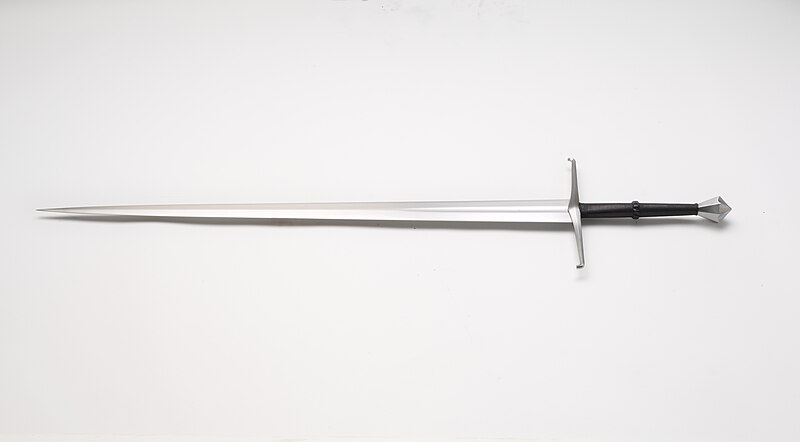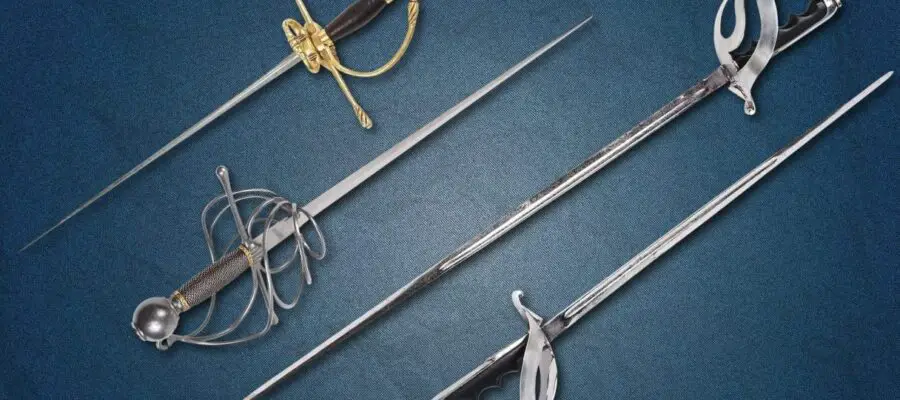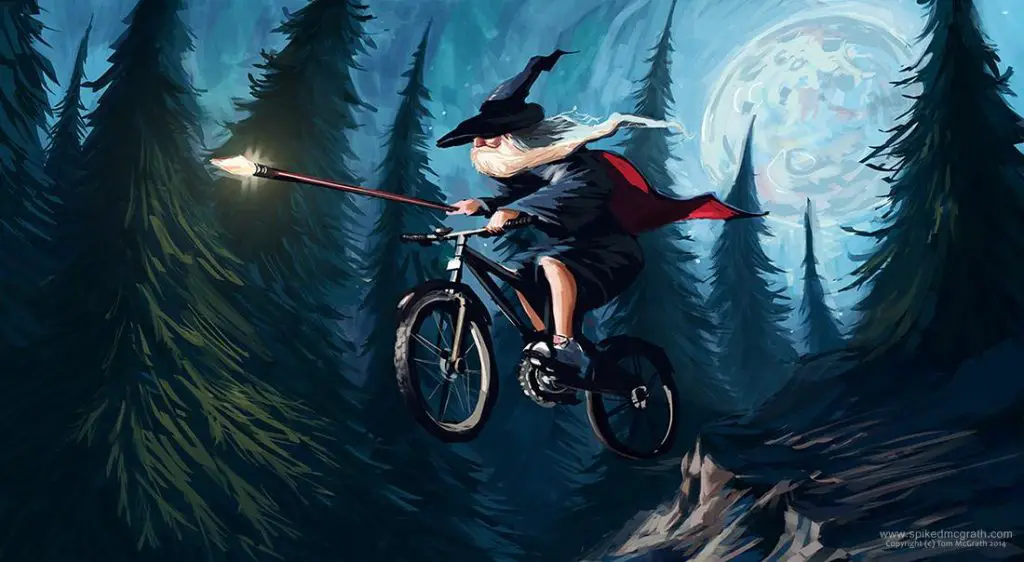In Dungeons and Dragons Fifth Edition, using weapons can be as simple as you wish. A table on pg. 146 of the Player’s Handbook will show you all of the necessary information: damage, weight, cost, et cetera.
But what if you had some extra knowledge about your weapon that could add flair and utility? Travelling through the jungle, you know your particular short sword is perfect for clearing away brush. Or, you use the hilt of your rapier to guard against an oncoming attack.
Some DMs will create special rules for their players’ weapons based on players’ interests and effort. Maybe you craft your own sword, and with knowledge of the historic Estoc sword in mind, your DM allows you advantage to pierce heavy armor.
Or maybe you have a streak of flair and love to describe the death-dealing blow in epic, historically accurate detail.
Whatever your reason, we’ve created an easy guide to 19 common swords in history.
Quick Links:
1. Falchion
2. Shortsword
3. Saber
4. Jian
5. Chokutō
6. Cutlass
7. Katana
8. Rapier
9. Longsword
10. Dao
11. Kodachi
12. Shamshir
13. Scimitar
14. Machete
15. Gladius
16. Claymore
17. Estoc
18. Basket hilted sword
19. Flame-bladed sword
Falchion
Falchion | 92 cm / 36.5 in
From Wikipedia: A Falchion (pronounced fall-chin) is a one-handed, single-edged sword of European origin with a slight curve on the blade toward the point. A falchion blade is thin and, on average, lighter than a double-edged blade. These weapons were not cleaving or chopping weapons similar to the machete, but quick slashing weapons.
From Medieval Chronicles: Commonly used in crusades, the Falchion is heavy enough to deal a forceful blow, sturdy enough to defend against an oncoming attack, and shaped precisely to carve through mail.
However, because of the shortness of the sword, a user put himself in danger of close-range combat while opening up himself to attacks due to the weight of the sword and the slashing motions.
Short Sword
Shortsword | 38-61 cm / 15-24 in
“You say my sword is short? It’s long enough to reach your heart.”
From Wikipedia: Short swords were made before the development of high quality steel that was necessary for longer swords. The short sword is an effective tool for clearing paths of brush and, jokingly, cutting cabbage.
From Medieval Chronicles: Useful in close combat, short swords were typically equipped by foot soldiers, criminals, or knights in medieval eras. Light and flexible, the short sword is one-handed, allowing the user to don a shield or wield an additional reach weapon.
Saber
Saber | 89 cm / 35 in
From Wikipedia: During the Napoleonic era, this single-blade backsword was commonly used by light mounted and dismounted cavalry. Though French sabers tended to curve, many Europeans fancied straighter sabers.
In fencing, the saber is a common dueling weapon, which allows for cuts and thrusts. Modernly, the saber is a ceremonial weapon, viewed as a badge of rank.
Jian
Image from Difference Engine, CC License
Jian | 45-80 cm / 18-31 in
From Wikipedia: The Jian (pronounced “Tshyen”) is a double-edged straight sword used during the last 2,500 years in China. Historical one-handed versions weigh an average of 700 to 900 grams (1.5 to 2 pounds). Two-handed varieties are larger and used for training in many martial arts.
A guard or hilt, described as short wings, protects the hand from an opposing blade. The longer two-handed handle could be used as a lever to lock the opponent’s arm if necessary. The end of the handle is finished with a pommel for balance, to prevent the handle from sliding if grip is lost, and for striking or trapping the opponent.
The blade itself is customarily divided into three sections for leverage in different offensive and defensive techniques: the tip of the blade is meant for stabbing, slashing, and quick percussive cuts; the middle section is used for a variety of offensive and defensive actions such as cleaving cuts, draw cuts, and deflections; and the section of blade closest to the guard is mainly used for defensive actions.
Jian were made from bronze and then steel, but in a ceremonial variety, Jian were carved from a single piece of jade.
Chokutō

Chokutō | 48 cm / 19in
From Wikipedia: The Chokutō is a one-edged straight sword produced prior to 9th-century Japan (before curved blades were introduced). These swords probably derived from ancient Chinese swords and methods of forging. Chokutō were used on foot for stabbing or slashing and were worn hung from the waist.
Cutlass
Image from Wikimedia user Rama, CC License
Cutlass | 60-70 cm / 23-29 in
From Wikipedia: A common naval weapon, the cutlass is a short, broad saber (slashing sword), with a straight or slightly-curved blade sharpened on the cutting edge. The hilt often features a solid cupped or basket-shaped guard.
Descendent of the short sword, the cutlass is famous for being used by pirates, who used this weapon for combat and intimidation, sometimes beating captives with the flat of the blade to force compliance.
The cutlass is also a versatile tool, often used agriculturally in rainforests and sugarcane fields, similar to a machete.
Katana
Katana | 60-73 cm / 23-28 in
From Wikipedia: A curved, slender, single-edged blade with a circular or squared guard and long grip to accommodate two hands, the katana is arguably the most well-known Japanese sword of the Samurai class in Feudal Japan. Western historians have said that katana were among the finest cutting weapons in military history.
Constructed from a traditional smelting process that results in several layers of steels with different carbon concentrations, the katana was often rid of impurities during hammering, which resulted in a stronger blade. Then several layers of a wet clay concoction are coated onto the blade, heated, and quenched in water, hardening the edge and causing a curve due to the difference in densities of the micro-structures in the steel.
The katana was often paired with a smaller sword, such as a wakizashi. The quicker draw of the katana was well suited to combat where victory depended heavily on short response times. The katana further facilitated this by being worn through a belt-like sash (obi) with the sharpened edge facing up. Ideally, samurai could draw the sword and strike the enemy in a single motion, like the infamous Rurouni Kenshin.
Rapier
Rapier | 104 cm / 41 in
From Wikipedia: The rapier is a long-bladed, slender, sharply pointed sword, weighing 1 kilogram (2.2 lbs). The rapier is characterized by a protective hilt to guard the hand wielding the sword. While the rapier might be broad enough to cut, it is designed to perform quick and nimble thrusting attacks.
Typically, rapier masters divided the blade into two parts (though some divide it into as much as 9). The forte (strong) is the first half and the part of the blade closest to the hilt. The debole (weak) is the second half and the part of the blade which includes the point.
The rapier has an advantage at longer distances between the user and opponent, but because it falls short with cutting power, it has low maneuverability at shorter distances. Thus rapiers, as single-handed weapons, are often employed with off-hand bucklers, parrying daggers, cloaks and even a second sword to assist with defense.
Longsword

Longsword | 100-130 cm / 39-51 in
From Wikipedia: The longsword is a European sword characterized as having a cruciform hilt with a grip for two-handed use prevalent during the late medieval and Renaissance periods. Longswords were used by on-the-ground infantry or mounted armored knights. There are many swords that fall under the category of “longsword,” which is here defined as requiring two hands at the hilt.
When fighting unarmored foes, a longsword user could cut and slice to deal instantly fatal or incapacitating damage. Thrusts to the skull, heart, or major blood vessels would cause massive trauma. Strong strikes can cut through skin and bone and amputate a foe’s limb.
When a foe is fully armored, a longsword user should focus less on cutting and slicing, as plate armor can not be penetrated this way, and should focus on concussive thrusting blows. The user should also look for opportunities for tripping, disarming, or tossing an opponent to throw off their defensive/offensive stances. This is called “Wrestling at the sword.”
Dao
Dao | 81-94 cm / 32-37 in
From Wikipedia: Considered one of the four traditional Chinese weapons, the dao is used for chopping and slashing, much like a sabre or broadsword.
Dao blades are moderately curved and single-edged, which allows effective thrusts. The hilt curves in the opposite direction of the blade, giving the user better maneuverability.
Chinese martial art schools still train with the Dao, as it is a versatile weapon, and the skills learned can be transferred to common objects, like canes or cricket bats. Think Jackie Chan in children’s movies.
Kodachi

Kodachi | 60-70 cm / 23-28 in
From Wikipedia: A typical weapon for the samurai class of feudal Japan, the kodachi is too short to be considered a sword and too long to be considered a dagger, which made it a primary short sword (unlike a wakizashi, which is a secondary short weapon dual-wielded with a longer sword like the katana).
Because the kodachi blade’s length did not exceed the limits of the legal blade length available to non-samurai during the Edo period, this sword was commonly carried by travellers, merchants, caravaners, and for self-defence against highwaymen, bandits, and brigands.
Shamshir
Shamshir | 92 cm / 36 in
From Wikipedia: A member of the curved-sword family, the shamshir is a heavily-curved Iranian sword, introduced to Iran by Turkey in the 12th century. The shamshir is one-handed with a slim blade with very little taper until the very tip. This sword was worn horizontally with the hilt and tip pointing upward.
The shamshir was typically used for slashing unarmored foes, mounted or on foot. The tip allows for thrusting, but the curvature of the blade made accuracy difficult.
The portion where the blade meets the hilt (the tang or shank) was often made of slabs of bone, ivory, or wood.
Scimitar
Scimitar | 76-92 cm / 30-36 in
From Wikipedia: Originating in the Middle East from at least the Ottoman period, the scimitar is a curved saber. The Persian word from which scimitar is derived literally means “paw claw.” However, scimitars hold symbolic importance in Arabic cultures, using different titles including “Sword of Truth,” “Sword of Submission,” and “Drawn Sword of God.”
Light-weight compared to other curved swords, scimitars were used in mounted combat. The curved design allows riders to slash enemies and keep riding without getting stuck, as stabbing with straight swords would.
Machete
Machete | 25-45 cm / 10-18 in
From Wikipedia: Used like an axe or a short sword, the broad-blade machete is commonly used for clearing brush, splitting coconuts, and guerilla warfare. Due to its cost-effectiveness, many common folk carry machetes as a tool.
Toughness is important in the manufacturing of machetes, as twisting and slashing are typical motions. A properly constructed machete will have a convex or flat primary bevel from the spine to the edge to facilitate this need.
Gladius
Image from Rama, CC License
Gladius | 60-85 cm / 24-33 in
From Wikipedia: The primary sword of Ancient Roman foot soldiers, the Gladius shines in both slashing and thrusting. This sword is two-edged for cutting and has a tapered point for stabbing during thrusting.
A solid grip is provided by a knobbed hilt, possibly with ridges for the fingers. Blade strength is achieved by welding together steel strips with a channel down the center.
Claymore
Image by Brianann MacAmhlaidh, CC License
Claymore | 120-140 cm / 47-55 in
From Wikipedia: The Claymore is a large Scottish two-handed sword, a symbol of physical prowess, weighing approximately 2.5 kg (5.5 lbs).
The sword is set with a wheel pommel often capped by a crescent-shaped nut and a guard with straight, forward-sloping arms ending in quatrefoils.
Escot
Image Source: Cleveland Museum of Art
Estoc | 92-132 cm / 36-52 in
From Wikipedia: Specifically designed to penetrate plate armor and chain mail, the estoc is a French cruciform, straight, two-handed longsword that lacks a cutting edge. Instead, the sword is acutely pointed such that the thrusted blade cross-section could split chainmail rings or slide between the joints and spaces in plate armor, like a lance would.
The estoc is most commonly used in hand-to-hand dismounted combat and mounted hunting of thick-skinned animals such as wild boars, bulls, and bears, though a second hunter would often be required to quickly finish off the wounded animal, as the estoc-wielder would be close enough for a swipe of the claw.
For hunting purposes, the tip of the estoc was replaced by a leaf-shaped boar-spear head, which allowed the user to use the weapon like a one-handed spear without over-penetrating.
Basket hilted sword
Basket hilted sword | 94 cm / 37 in
From Wikipedia: Used especially by heavy cavalry up to the Napoleonic era, the basket hilted sword, often referred to generally as a broad sword, was a cut-and-thrust military sword with a beautiful basket-shaped hilt.
Contrary to the rapier, which was a commonly-used civilian sword of the same era, the basket hilted sword was heavy and often double-edged.
Flame-bladed sword
Flame-bladed sword | 130 cm / 51 in
From Wikipedia: Named for its flame-like appearance while in use, this wavy sword is akin to a rapier.
While largely decorative, the unique undulating shape of the blade provides some unique benefits: a parrying foe’s blade may receive troublesome vibrations that increase friction in the foe’s sword; there are many cutting edges while the sword itself retains a straight shape; a foe cannot easily grab the blade.
Which swords are you an expert on? Has your Dungeon Master allowed you special feats with your custom sword? Let us know in the comments!




